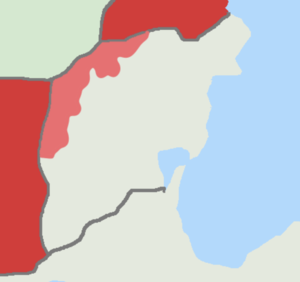Difference between revisions of "Insurgency in Roscommon"
| (7 intermediate revisions by 3 users not shown) | |||
| Line 22: | Line 22: | ||
| status = Ongoing | | status = Ongoing | ||
| combatants_header = | | combatants_header = | ||
| − | | combatant1 = | + | | combatant1 = {{flagdeco|Gjorka}} [[Second Gjorkan Republic|Military government]] (1951-1972) |
| − | + | * {{flagdeco|Gjorka}} [[Garda Gjorkan]] | |
| − | * | + | * {{flagdeco|Gjorka}} [[Gjorkan National Armed Forces]] |
| − | * | + | * {{flagicon image|Black flag.svg}} [[Pro-government militias in the Gjorkan Resistance|Pro-government militias]] |
| − | * | ||
---- | ---- | ||
| − | + | {{flagdeco|Gjorka}} [[Gjorka|Democratic government]] (since 1972) | |
| − | {{ | + | * {{flagdeco|Gjorka}} [[Garda Gjorkan]] |
| − | * {{ | + | * {{flagdeco|Gjorka}} [[Gjorkan National Armed Forces]] |
| − | * {{ | + | | combatant2 = {{flagicon image|KhoyrSoc.png}} [[Front for the Liberation of Khoroshiya]]<br />{{flagicon image|KAR-KAD flag.png}} [[KAR – KAA|Khoroshiyan Anti-Fascist Movement]] |
| − | | combatant2 = | + | '''Supported by:''' <br />{{flag|Ajakanistan|1921}} (1951-2023; alleged)<br />{{flag|Zloveshchiy}} (alleged) |
| − | '''Supported by:''' <br /> | ||
| − | <br /> | ||
---- | ---- | ||
| − | + | {{flagicon image|KhorFas2.png}} [[Vovk Battalion]] (1955-1983) | |
| − | | combatant3 = | + | | combatant3 = {{flagicon image|FascismFlag.png}} Right-wing paramilitaries |
| − | * | + | * {{flagicon image|ValkistFront.png}} [[Valkist Front (Gjorka)| Valkist Front]] (since 1983) |
| − | |||
| commander1 = | | commander1 = | ||
| commander2 = | | commander2 = | ||
| Line 57: | Line 53: | ||
}} | }} | ||
| − | The '''Insurgency in Roscommon''' is an ongoing low-level conflict in the [[Gjorka|Gjorkan]] [[Districts of Gjorka|District]] of [[Roscommon]] with spillovers into the rest of Gjorka. Roscommon is home to a majority of Gjorka's 500,000 [[Khoroshiyans]] whom have faced [[Anti-Khoroshiyan sentiment|significant discrimination]] within Gjorka. The conflict began in 1951 with the formation of the [[Front for the Liberation of Khoroshiya]] following an increased campaign of violence against Khorshiyans. The left-wing front along with it's right-wing counterpart, the [[Vovk Battalion]], resisted the [[Second Gjorkan Republic|military government]] during the [[Gjorkan Resistance]]. Following the [[ | + | The '''Insurgency in Roscommon''' is an ongoing low-level conflict in the [[Gjorka|Gjorkan]] [[Districts of Gjorka|District]] of [[Roscommon]] with spillovers into the rest of Gjorka. Roscommon is home to a majority of Gjorka's 500,000 [[Khoroshiyans]] whom have faced [[Anti-Khoroshiyan sentiment|significant discrimination]] within Gjorka. The conflict began in 1951 with the formation of the [[Front for the Liberation of Khoroshiya]] following an increased campaign of violence against Khorshiyans. The left-wing front along with it's right-wing counterpart, the [[Vovk Battalion]], resisted the [[Second Gjorkan Republic|military government]] during the [[Gjorkan Resistance]]. Following the [[Black Revolution]] and end of the military government, the Insurgency continued on as the new [[Third Gjorkan Republic|democratic government]] refused to allow Khoroshiyans to run for office. Despite this over the next decades the conflict de-escalated as violence against Khoroshiyans subsided. The Vovk Battatlion disbanded in 1983, and by 1991 most historians agree the conflict was no longer a major insurgency. The conflict nearly ended in 2003 when [[President of Gjorka|President]] [[Joe Wallace]] lifted the ban on Khoroshiyans running for office as the Front considered disbanding as a result. However, the conflict began to re-escalate following the assumption of [[Joseph Marnell]] to the presidency. Marnell effectively re-instituted the ban on Khoroshiyans running for office as he banned anyone with ties to the Front or other anti-government groups which covered nearly all Khoroshiyan politicians. Since then the conflict has remained low-level as the Front remains focused on political activism rather than militant but attacks still occur. The most notable event recently being the [[2021 Ratoath Riots]]. |
{{Gjorka topics}} | {{Gjorka topics}} | ||
[[Category:Terraconserva]] | [[Category:Terraconserva]] | ||
Latest revision as of 00:13, 22 October 2023
| Insurgency in Roscommon | ||||||||
|---|---|---|---|---|---|---|---|---|
 Areas of Gjorka with Khoroshiyan population | ||||||||
| ||||||||
| Belligerents | ||||||||
|
|
|
| ||||||
| Units involved | ||||||||
|
Garda: 170,000 officers (2022) Armed Forces: 176,890 active duty (2022) | Unknown, 1,000+ (2022 Estimate) | Unknown, 200+ (2022 Estimate) | ||||||
The Insurgency in Roscommon is an ongoing low-level conflict in the Gjorkan District of Roscommon with spillovers into the rest of Gjorka. Roscommon is home to a majority of Gjorka's 500,000 Khoroshiyans whom have faced significant discrimination within Gjorka. The conflict began in 1951 with the formation of the Front for the Liberation of Khoroshiya following an increased campaign of violence against Khorshiyans. The left-wing front along with it's right-wing counterpart, the Vovk Battalion, resisted the military government during the Gjorkan Resistance. Following the Black Revolution and end of the military government, the Insurgency continued on as the new democratic government refused to allow Khoroshiyans to run for office. Despite this over the next decades the conflict de-escalated as violence against Khoroshiyans subsided. The Vovk Battatlion disbanded in 1983, and by 1991 most historians agree the conflict was no longer a major insurgency. The conflict nearly ended in 2003 when President Joe Wallace lifted the ban on Khoroshiyans running for office as the Front considered disbanding as a result. However, the conflict began to re-escalate following the assumption of Joseph Marnell to the presidency. Marnell effectively re-instituted the ban on Khoroshiyans running for office as he banned anyone with ties to the Front or other anti-government groups which covered nearly all Khoroshiyan politicians. Since then the conflict has remained low-level as the Front remains focused on political activism rather than militant but attacks still occur. The most notable event recently being the 2021 Ratoath Riots.
